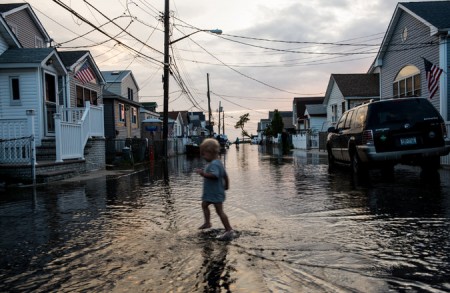November 30, 2015 – This summer my wife and I visited Passau, Germany, located at the confluence of three rivers, The Danube, Inn and Ilz. You won’t find many prettier places than Passau, a city that hugs its river banks with passion, and is home to Europe’s largest pipe organ located in baroque St. Stephen’s cathedral. Talk about a concert organ. The cathedral sits high on a hill overlooking the river with much of the town below. The picture below is the city we saw in August. Temperatures were in the mid 30s Celsius (90 plus Fahrenheit). It had not rained for days.
Now take a look at the picture that follows. This is the same city in June of 2013. The Danube peaked at 12.8 meters (almost 42 feet) above normal that late spring. It didn’t reach the cathedral but the high water mark threatened, something never seen before.
The German reinsurance company, Munich Re, calculated damage to Passau and other cities and surroundings at 12 billion Euros. Of that total 3 billion was covered and Munich Re paid twice as much to claimants as it did in any previous big flood, the last one being in 2002. For the directors of the company the 2013 flood was more than writing on the wall. It was time to get serious about climate change. Get serious or go broke. If you are unfamiliar with Munich Re, short for Münchener Rückversicherungs-Gesellschaft AG, it is one of the largest reinsurers in the world, underwriting other insurance companies policies, and employing 45,000 with a market value of 27 billion Euros.
Munich Re wasn’t the only company to feel the pain of the flood. It was joined by Swiss Re, a direct competitor, and Lloyd’s of London, who all noted rising claims related to extreme weather. Munich Re and its competitors looked back to the 1970s and as they tracked claims made noted the steady rise related to weather. The conclusion, that anthropogenic climate change was happening.
At Swiss Re they studied climate change and calculated that it would impact the world economy reducing gross domestic product (GDP) by 20% by century end. The company co-hosted a May meeting this year in Zurich inviting reinsurers and insurance companies from around the world to prepare a position for the upcoming COP 21 climate meetings that, as you know, opened today in Paris. We’ll be covering some of the activities and announcements from COP 21 over the next few days and I am sure some of these will come from the insurance industry.
What came out of the May meeting was a set of principles for sustainability, mitigation and adaptation laid out in a report entitled, Insurance 2030: Harnessing Insurance for Sustainable Development. The document describes the key challenges faced by humanity facing climate change and weather events. On page 12 it states “in the past decade, 80% of natural disasters were climate related, and climate change is predicted to increase the frequency and intensity of extreme weather events such as floods and storms.” Further in the report, Henri de Castries, CEO of the AXA Group, a leading insurance and asset management company, states, “Climate risk for us is neither an ideological or theoretical issue: it is a core business issue. As long as the ‘systemic risk’ of carbon is not correctly embedded into regulatory frameworks, through efficient ‘carbon pricing’ mechanisms and more broadly favourable treatment for longer-term investments that are necessary to limit climate risks, it will always be a story of a few responsible actors doing their best within a broader financial system that is not designed for sustainability.” In other words the industry through this spokesperson is calling for a global carbon price as a means to low-carbon energy alternatives and a low-carbon economic future.
In today’s The Globe and Mail, in Toronto, the lead article in Report on Business is entitled “Insurers look for new ways to cope with climate change.” The largest property insurer in Canada, Intact Financial Corp., is joining with University of Waterloo, home of The Perimeter Institute, to form the Intact Centre for Climate Adaptation, to conduct research on mitigation and adaptation strategies. Considered a national initiative, the company and university have selected 20 climate change adaptation projects from 75 submissions from across the country to showcase viable adaptation. Projects include fighting coastal erosion near major cities, public education, measures for homeowners to deal with basement flooding and other domestic and national infrastructure improvements. Charles Brindamour, CEO of Intact is quoted stating, “This is a multi-stakeholder endeavour and we are thankful to the governmental agencies, NGOs and consumers that will participate in these projects. Together we will foster adaptation initiatives that will allow Canadians to better adapt to our changing climate.”
A final quote that spells out the reinsurance industry’s position is worth remembering…“preparing for climate change is non-negotiable.” The financial and social costs cannot be borne by insurers, re-insurers, government and individuals without adaptation and mitigation. It cannot be done without putting a price on carbon. So it is for selfish reasons that the industry is battening down the hatches. It’s about their bottom line, the billions and trillions of dollars it will ultimately cost without immediate intervention.














[…] the industry, the effects of climate change are seen in the broadest socioeconomic context. I have written in the past about reinsurers like Swiss Re and Munich Re who track natural disasters based on insurance losses. These companies […]